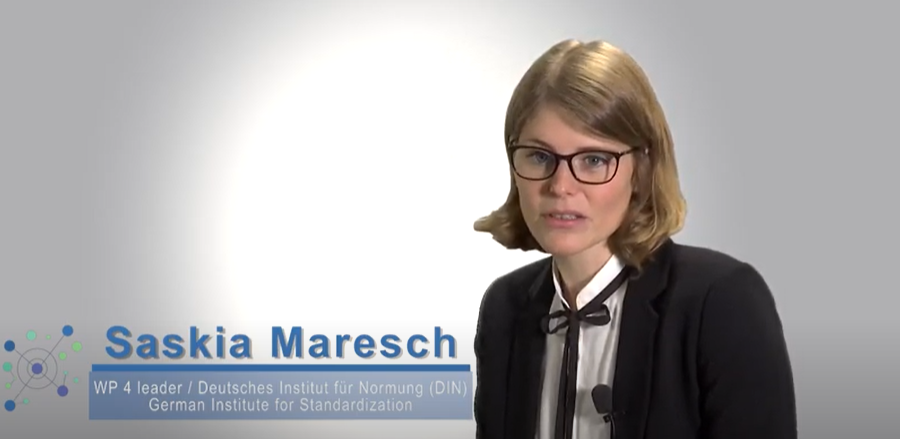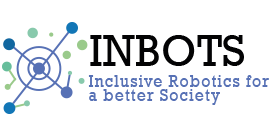INBOTS is working to develop a standardization and benchmarking strategy related to horizontal aspects of interactive robots, like their safety or performance in different application domains such as medical, industry, consumer and service. This activity is led by Deutsches Institut fuer Normung (DIN) at the Work Package 4 that in collaboration with other partners, is working on identifying current needs in standardization and benchmarking of performance and safety of interactive robots in different application domains. They have been analysing the impact of close human-robot interaction for standardization and benchmarking and defining an integrated approach for performance, safety and human factors & ergonomics.

To know about the progress of this work, we have been talking with Saskia Maresch, Project Manager at Deutsches Institut fuer Normung (DIN) and the leader of this Work Package.
Can you briefly explain what standardisation needs have you identified?
We identified for example standardisation needs concerning test methods and performance criteria. A general observation is that the safety aspect is well covered in standards, while performance-related aspects are less covered. There is a need to define standards for specific technologies. For some technologies standardisation activities are more advanced, e.g. COBOTS, while in manufacturing there is no standard for exoskeletons and AGVs. There is also a standardisation need to define the boundaries between different domains and activities concerning ethical issues are currently increasing. In the future, more guidance documents should be developed on how to apply a standard or a standard series should be developed.
What approaches have been developed to include horizontal aspects into standardisation activities?
The key to working on overlapping topics is communication and that there are different document types besides standards. Standardisation activities can be initiated for different types of document, e.g. specification, report and agreement. One approach to include horizontal aspects in standardisation could be through the funding of European research projects with a Technology Readiness Level of six or higher. Research projects usually consist of a diverse group of experts that have the goal to develop something together. INBOTS for example brings together lawyers, entrepreneurs, philosophers, researchers and standardisation experts. Since research projects are groups that only work together temporary it is very important to create a mutually beneficial working relationship with existing technical standardisation committees (e.g. ISO/TC 299).
Since research projects are groups that only work together temporary it is very important to create a mutually beneficial working relationship with existing technical standardisation committees
In the end, the goal is to create a consensus-based document that is widely accepted by all stakeholders. A practical example is a joint initiative from the INBOTS and EUROBENCH project to develop a CEN Workshop Agreement (CWA) on a performance test method for lower-limb wearable devices for walking on uneven terrain. The chairperson of this CWA is a standardisation expert of ISO/TC 299 and the development group consist of project partners from INBOTS, EUROBENCH and other stakeholders.
Draft CWA “Lower-limb wearable devices – Performance test method for walking on uneven terrain” is available for public review and commenting from December 2020 to January 2021 on https://www.cen.eu/News/Workshops/Pages/WS-2020-015.aspx and https://www.cencenelec.eu/news/workshops/Pages/WS-2020-013.aspx. We hope to increase the acceptance of the CWA through openness and exchange with the already existing technical committees and that the CWA is maybe uplifted to a European or International Standard.
What will be the next challenges to face regarding standardisation and benchmarking?
From talking with organisations, we found out that, they face challenges with standardisation because of the too time-consuming and complex development process of standards. The good news is that the standardisation system already realised this issue and that they initiated countermeasures that shorten the process and fosters the development of specifications and agreements, which can be developed in a shorter time period. Another challenge is the economic uncertainties of putting the own country first and that this might lead to a decrease in international standardisation activities. Standardisation of technologies is also getting more challenging, because of the speed with which they change. The functional behaviour of the devices should therefore be standardised considering also the adaptive systems because otherwise it will be exceeded by technology. There are many more standardisation needs and challenges and I recommend to have a look at the INBOTS White Paper that will be published in 2021 for more information.
How has COVID-19 affected your activities in WP4?
A large part of the project is communication and although some of the conferences were held virtually, interaction was limited. The advantage of virtual meetings or conferences is that more people can join and therefore more people can be reached. The disadvantage is that it is more challenging to keep up the attention of the audience and that the coffee break talks are missing.
